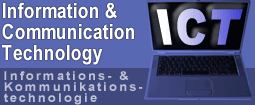|
 |
E-Learning |
|
|
 |
E-Learning |
e-Learning
is the transmission of content through information technologies and didactics.
Only the harmonious interplay between these three elements will lead to
the successful implementation of e-learning.
There
are two main forms of e-learning:
 |
distance
learning |
 |
advanced
distributed learning (ADL) |
Course
content, the didactic methods, and the applied information technology vary,
depending on the form of e-learning.
 |
Distance
Learning |
Distance
learning supports teaching through IT and is based on computer transmitted
human-to-human interactions: The interaction between teacher and students
is the main objective, and the computer is used as a medium of interaction.
Using
distance learning, students become more responsible for their own learning
process than is the case with traditional learning methods, since they
can decide when and where they learn. They can also choose learning material
that suits their interests and levels of knowledge.
Online
courses are a crucial element of distance learning, and they are often
accompanied by teacher-student interaction through a virtual learning environment,
or web classroom. See e-Learning / Distance Learning for more information.
Advanced
Distributed Learning (ADL)
ADL
is the next step on from distance learning. While distance learning depends
on students and teachers being at the right place at the right time, ADL
provides learning at any time, anywhere.
ADL
provides a method of learning that is independent of people and institutions.
It relies on human-to-computer interaction; special software - such as
a learning management system (LMS) - supports the learning process
and provides learning content in the form of learning objects.
 |
e-Learning
/ Distance Learning |
Distance
learning is the IT-based support of teaching. It is based on computer-transmitted
human-to-human interactions: The interaction between teacher and students
is the main objective, and the computer is used as a medium of interaction.
It is used as an intermediary to facilitate various aspects of teaching,
to provide support, and where appropriate to individualize the learning
process. Distance learning, like other forms of e-learning, is ideally
suited to various types of course content, didactic methods, and information
technologies.
 |
The
'Right Time, Right Place' Paradigm |
One
of the general conditions of teaching by distance learning is that teaching
occurs according to the "right time, right place" paradigm: Students need
to be in the right place (or at least at a computer) at the right time
in order to learn, that is, they are bound to a schedule or a timetable.
In addition, teaching is linked to specific teachers, "the right person".
The teacher has a personal teaching style and a specific approach to teaching.
He or she will communicate, discuss issues, and interact with the students,
in particular, in the form of seminars. Each class has a fixed number of
learners or students. And distance learning courses are usually run by
a specific institute, so that certain institutional prerequisites have
to be met - for example, an institute might demand that its students are
tested regularly on what they have learnt and awards them a specific credit
or degree if they pass.
 |
Courses |
Courses
are the traditional form of distance learning. They are often accompanied
by teacher-student interaction through a virtual learning environment,
or "web classroom".
|


